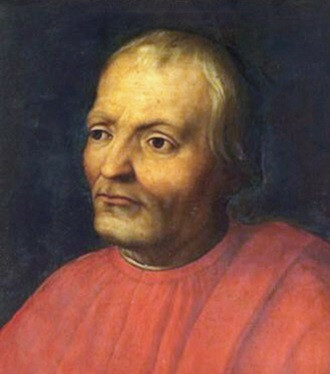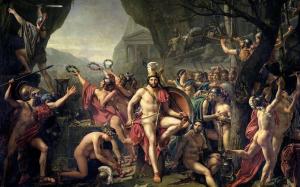What was the Medici Florence like?
The Medici marked a definitive stage in the history of their native Florence. Symbols of the near-absolute power of a city that nevertheless still sold itself as a republic, their wealth and network of contacts allowed them to rapidly climb the ranks of power.
join us in the story of the most powerful family of the Florentine Renaissance.
The Florence of the Medici and humanism
At the end of the Middle Ages, a new ideological current began to take shape in the cities of the Italian Peninsula, which would have its culmination in the Florence of the Quattrocento. This current, which has been called humanism, had its roots in medieval cathedral schools, such as the famous school of Chartres. However, It is not until the end of the 14th century and the beginning of the 15th that humanism began to gain strength., hand in hand with the new philosophical currents.
Before in the artistic field, the Renaissance occurred in the literary and philosophical field. Thinkers like Marsilio Ficino (who translated Plato's work in 1484), Bruni and Pico della Mirandola gave impetus to Neoplatonism, which they tried to assimilate with Christian theory. But, above all, what mainly characterizes Renaissance humanism is the fact of placing the human being at the center of everything.
Unlike medieval theocentrism, in which everything revolved around God, the Renaissance humanist understood that the human being, as created in the image and likeness of God, was the most important of divine creation and the center of the universe. Hand in hand with this new conception of reality, art becomes on a “human scale”. The soaring Gothic cathedrals give way, then, to Renaissance buildings, where horizontality predominates and whose proportions are more appropriate to human measurements.
- Related article: "The 5 ages of History (and their characteristics)"
Florence at the beginning of the Renaissance
At the end of the 14th century, Florence was in a moment of frank economic and artistic prosperity. Its importance was great among the numerous city-states that dotted the still ununified Italy. However, in the 1390s, the troops of Gian Galeazzo Visconti, Duke of Milan, began to insistently harass the Florentine Republic.
Faced with the Milanese threat, which had already taken cities such as Siena and Bologna under its power, Florence closed its doors, with the damages that this self-isolation entailed for a state that based its wealth on trade. However, this situation only strengthened their republican values, against the princely system of government represented by the Visconti.
The incursion of the Milanese troops was repeated in the 1420s, when Filippo Maria Visconti repeated his father's attempt to subjugate the Florentine territories. The defeat of the Florentines was avoided through the city's alliance with Venice, which was successfully settled in 1425.
The Republic of Florence was one of the most careful governments in Europe, since, to guarantee republican goodness, the balances of power were scrupulously watched. We have already commented that the republican values of Florence were very clear in the population, which in no way wanted to become a principality, like its neighbors in Milan.
However, as we will see in the following sections, the reality was very different. The Medici began to climb the ranks of power, and although Florence nominally remained a Republic, the family had their extraordinary wealth to do and undo as they pleased, which turned the Republic into a principality covert.
- You may be interested in: "The Renaissance: what it is and what are its characteristics"
Bankers to the Pope and patrons of artists
Although the Medici genealogy goes back as far as the 11th century, the first prominent member is Giovanni di Bicci de' Medici, who founded the famous Banca Medici and went from being a simple moneylender to being the official banker of the papacy.

This lucrative business brought Giovanni a considerable fortune that, letting himself be carried away by the humanist current of the moment, he knew how to invest him wisely in the creation of fabulous works of art and, above all, in the patronage of artists such as Masaccio, Brunelleschi and Donatello.
Not only the love for art was the one that motivated this interest. Giovanni knew, like all the powerful, that art could be one of the fastest vehicles of promotion and propaganda, so he did not hesitate to immerse himself fully in the artistic life florentine.
The artistic patronage of the Medici in Florence, as well as the beginning of their rise to power in the city, began in 1418, when Giovanni led the initiative of several citizens of the San Lorenzo neighborhood who wanted to contribute funds to build a parish. Each of the families would build their own chapel in the church and, obviously, Giovanni was not going to be less. With the Medicean funds, the sacristy was built, which was also projected from the beginning as a family mausoleum.
The location of the mausoleum in the new parish of San Lorenzo was not accidental. A paleo-Christian church from the 4th century had been built on the site, consecrated by none other than Saint Ambrose. The religious symbolism of San Lorenzo was, therefore, greater than that of the Duomo, later enshrined. With this action, the Medici made their claims very clear.
The year in which the construction of San Lorenzo began coincides with the time when Giovanni di Bicci de Medici he becomes a papal banker, which obviously constituted an important source of wealth for the family. It was this wealth that allowed them to hold, de facto, the power of the city; and although Florence was nominally still a republic, the Medici practically served as princes. Precisely, against what the Florentines had been fighting since the end of the 14th century.
- Related article: "The 8 branches of the Humanities"
symbols of power
The Medici soon launched a propaganda campaign through new artistic productions, beginning with their own residence. It was Giovanni's son, Cosimo, who led this unstoppable rise that, since 1434, led the family. He never held government positions, but he did direct the political life of the Republic from the shadows. A similar power required an adequate symbology, and Cosme found it in the main artists of the moment.
In 1446, Cosimo commissioned Michelozzo to build the family residence, the Medici Palace.. The palace, which absorbed the old parish church of San Lorenzo within its walls, was characterized by being openly inspired, and for the first time by Florentine art, by classical models. On the other hand, the palatine chapel displays the magnificent frescoes of the Procession of the Magi, executed by Benozzo Gozzoli and which represent a true apotheosis of Medicean power, since the family was portrayed among the members of the entourage.
The frescoes were executed in 1449 and are kept in the Medici-Riccardi palace. Among the Medici represented in the procession, the portraits of Cosme, of Piero 'El Gotoso' and a very young Lorenzo, who will later be acclaimed as 'El Magnifico', stand out.
The appearance of the effigies of the family in the chapel was a very clear allusion to the power that the Medici held in the city. Not only that: he placed them in a religious framework that "demonstrated" his devotion and magnificence. Let us not forget that the men of the family paraded in the procession with the brotherhood of the Three Wise Men, which came out, every January 6, from the church of the convent of San Marcos, where, supposedly, the relics of the Kings. The procession passed through the Medicean palace, making clear with this fact the privileged situation of the family.
rival families
Unsurprisingly, not everyone in Florence loved and admired the Medici. Such power always arouses suspicion and envy, and there were many families that disputed that position of power.
Cosme's leadership ran into the interests of another of the Florentine families, the Albizzi. In 1433, and due to an accusation of embezzlement of public funds, Cosme was forced to flee Florence. However, a year later, it was the Albizzi who fell out of favor and were banished from Florence. Cosme's power in his city had redoubled. Nobody doubted anymore that, although technically they still lived in a republic, the Medici, with Cosimo at their head, were the undisputed lords of the place.
On Cosme's death, his grandson, Lorenzo, rose to power. At this time the enemy had changed: the Albizzi were no longer the threat of Medicean power, but another family, the Pazzi. It is in this context that the well-known Pazzi conspiracy, a plot orchestrated by the rival family and by the Pope himself, Sixtus IV. The plan was to assassinate the Magnificent when he was coming out of hearing mass in the Cathedral of Santa Maria in Florence. And although Lorenzo was saved, his brother Giuliano died in the attack. Lorenzo took long revenge on his enemies; after killing them, he had their corpses hung in the Palazzo della Signoria, in addition to allying himself with Naples against the pope.
the florentine academy
Cosimo de Medici had sponsored the Careggi Academy, an unofficial circle where humanist followers of Neoplatonism promoted by Marsilio Ficino met. The Florence of the Medici thus stands as a model to follow for the rest of the Italian cities, not only in the philosophical-literary field, but also artistic.
Cosme's grandson, Lorenzo, was the protagonist of an authentic cultural revolution. A great patron and protector of artists and thinkers, he continued to promote the Florentine academy, as well as of acquiring a vast library of classics, supplied by humanists such as the traveling salesman Giovanni Aurispa.
With Lorenzo, art is imbued with Neoplatonic philosophy, and the works of contemporary artists, such as Botticelli or Miguel Ángel, follow the precepts developed by the Academy, which deal with topics such as platonic love or immortality of the soul. Not even the harangues of the Dominican Savonarola against these "banalities", which sowed terror to the Republic, they could with that universe of beauty and philosophy that supposed that the Florence medicea.


